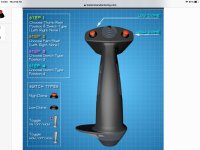Craw
Active Member
Gooday Folks,
I have completed what I believe to be a good first draft of a G3X IFR setup for an RV-7A I'm building. This is my first pass so please be gentle.
I'm looking for a review of the drawings I've done and have provided links to a high-level pdf for the power distribution as well as a detailed set that includes everything. Just a few notes for anyone brave enough to review my layout:
1. I intend to fly with a backup handheld radio in case I ever need to run of the IBBS. That would allow me to land ASAP using the backup avionics and G5 along with the handheld and an iPad.
2. I will be installing a TailbeaconX ADSB-Out antenna so need a separate set of strobes to cover the full range as the tail light provided by FLY LEDs wont be installed.
Thanks all in advance for your input and please let me know if you find a ground or pin that is wrong or mislabelled.
---Note--- 02/11/22
I amended the drawings to incorporate some of the feedback provided in this thread and other omissions I found:
- Re-ordered centre stack to put the GTN GPS as high as possible without behind panel interference.
- Separate power pins for left and right landing lights to support the VP-X Pro Wig Wag function via pulsing to the different power pins (thanks Paul!).
- Updated stick grip images to be consistent (note the stick grip shown on one image has an aux toggle switch the actual sticks have momentary push button).
- Added missing yellow line for input on stick grip wiring.
- Replaced erroneous circuit breaker icon with correct fuse icon.
- Updated ANL/Alternator & Contactor placement on Overview diagram.
- Re-ordered switches to provide better flow management given available panel space and avoid one straight line of switches across the bottom.
All the best!
I have completed what I believe to be a good first draft of a G3X IFR setup for an RV-7A I'm building. This is my first pass so please be gentle.
I'm looking for a review of the drawings I've done and have provided links to a high-level pdf for the power distribution as well as a detailed set that includes everything. Just a few notes for anyone brave enough to review my layout:
1. I intend to fly with a backup handheld radio in case I ever need to run of the IBBS. That would allow me to land ASAP using the backup avionics and G5 along with the handheld and an iPad.
2. I will be installing a TailbeaconX ADSB-Out antenna so need a separate set of strobes to cover the full range as the tail light provided by FLY LEDs wont be installed.
Thanks all in advance for your input and please let me know if you find a ground or pin that is wrong or mislabelled.
---Note--- 02/11/22
I amended the drawings to incorporate some of the feedback provided in this thread and other omissions I found:
- Re-ordered centre stack to put the GTN GPS as high as possible without behind panel interference.
- Separate power pins for left and right landing lights to support the VP-X Pro Wig Wag function via pulsing to the different power pins (thanks Paul!).
- Updated stick grip images to be consistent (note the stick grip shown on one image has an aux toggle switch the actual sticks have momentary push button).
- Added missing yellow line for input on stick grip wiring.
- Replaced erroneous circuit breaker icon with correct fuse icon.
- Updated ANL/Alternator & Contactor placement on Overview diagram.
- Re-ordered switches to provide better flow management given available panel space and avoid one straight line of switches across the bottom.
All the best!
Attachments
Last edited:






